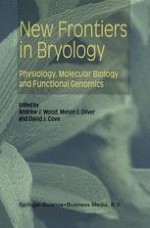
2004 | OriginalPaper | Buchkapitel
Molecular Phylogeny of Bryophytes and Peculiarities of Their Chloroplast and Mitochondrial DNAs
verfasst von : Volker Knoop, Yin-Long Qiu, Koichi Yoshinaga
Erschienen in: New Frontiers in Bryology
Verlag: Springer Netherlands
Enthalten in: Professional Book Archive
Aktivieren Sie unsere intelligente Suche, um passende Fachinhalte oder Patente zu finden.
Wählen Sie Textabschnitte aus um mit Künstlicher Intelligenz passenden Patente zu finden. powered by
Markieren Sie Textabschnitte, um KI-gestützt weitere passende Inhalte zu finden. powered by
Molecular sequence data have contributed enormously to our knowledge about the phylogeny of land plants. Bryophytes are of fundamental importance to the full picture of land plant evolution as it is becoming increasingly evident that they represent the extant relatives of the earliest land plants. The three classically distinguished bryophyte classes mosses, liverworts and hornworts each are confirmed as well founded monophyletic groups by the majority of molecular data. However, it has also become clear that the term bryophytes describes a division, which is a paraphyletic group — most likely with only one of its classes linked to the vascular plants and another one sister to all other land plants. Hitherto enigmatic genera like Takakia or Haplomitrium can now be phylogenetically assigned and more detailed placements of these and other genera will be straightforward with yet more informative data accumulating. The use of concatenated alignments will likewise resolve other questions on the monophyly of orders or families defined by classical systematics and will paint a clear picture on their branching pattern. Extending the conventionally used nuclear gene sequences (mostly ribosomal RNA genes) or chloroplast gene markers, the plant mitochondrial genes appear to be of particular suitability to address questions of deep level plant phylogeny. Two idiosyncratic phenomena of gene expression in plant organellar DNAs make their evolution particularly interesting: RNA editing and Trans-Splicing. RNA editing, the frequently observed site-specific exchange of pyrimidines to reconstitute conserved codon identities is class-specifically shaped in the bryophytes: Moderate exchange of cytidine to uridine is observed in mosses — very similar to angiosperms, where the phenomenon was discovered. Hornworts, however, display a strikingly higher frequency of pyrimidine exchange and, most notably, many replacements in the opposite direction, i.e. from uridine to cytidine. A peculiar case are the liverworts where we observe RNA editing of variable frequency among taxa in the jungermanniid species but so far a mysterious absence of RNA editing in the marchantiid mitochondrial sequences. Two other genomic features make the mitochondrial DNA of plants particularly well suited for deep level phylogenetic analyses: A very low primary sequence drift coinciding with a low degree of homoplasy and the presence of characteristic, positional stable organellar introns, mostly of the group II type. Investigating the intron-rich genes nad5, nad2, nad4 and nad7 one finds that intron presence fully coincides with class membership, with the mosses displaying spermatophyte-type mitochondrial introns. These and other observations so far converge on the liverworts as sister group to all other land plants.